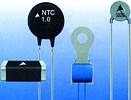
Protection of electronic equipment against failure is a critical market demand and an obligation to consumers at the same time. Taking years of experience, competence and innovation to always offer reliable and economical solutions, Epcos is one company that has what it takes.
Following our look at gas-filled surge arresters in Part I, this article continues now with a look at NTC thermistors.
NTC thermistors
Thermistors are used as temperature sensors as well as for protection and switching. NTC (negative temperature coefficient) thermistors protect against current peaks and cut costs in all equipment containing switch-mode power supplies (SMPS). These inrush current limiters with integrated loss reduction can perform all the functions of fixed resistors and also reduce power consumption significantly in the equipment in which they are used.
NTC thermistors are mainly used in SMPS for computers and peripherals, entertainment electronics equipment, fluorescent lamps and ballasts for high-intensity discharge lamps. They protect components connected in series, such as diodes and switches.

David Connett, product marketing manager for ceramic sensors and systems at Epcos, explains, "NTC thermistors give a soft start to motors with continuous currents up to 20 A, as found in vacuum cleaners. Thanks to their low resistance in the operating state, their power dissipation is considerably lower than that of the fixed resistors widely used for this application. They are also lighter, more compact and suitable for automatic placement."
A broad range of NTC thermistors with various disk sizes and resistances allows optimal matching to the particular application. It extends from disks with a diameter of 8,5 mm and maximum power dissipation of 1,4 W at 25°C up to types with a diameter of 26 mm and maximum power dissipation up to 6,7 W. Resistance ranges from 1 to 80 Ω, maximum permissible continuous currents from 1,3 to 20 A. NTC thermistors can be used in both AC and DC circuits with voltages up to 265 V.
NTC sensors also monitor the internal temperature of high-end drives. A controller gives the turnoff signal when the maximum permissible temperature is exceeded. An NTC thermistor is located on the control board. If the temperature exceeds a specific value - the typical limit is 55°C - it can switch on a cooling fan, reduce the drive speed or even shut down the drive completely. High-precision NTC thermistors from Epcos with a tolerance up to ±0,2 K in the temperature range from 0 to 70°C ensure exact temperature monitoring. Their accuracy is determined by the B value, which describes the profile of the R/T curve, as well as their resistance tolerance and resistance drift after soldering. Epcos can achieve B value tolerances of 0,5% with a resistance drift of less than 1% after soldering.
NTC thermistors from Epcos are available in numerous sizes and materials and with various cable and connector geometries. In Part III of this series to follow, we will examine PTC thermistors. PTC, for positive temperature coefficient, are thermistors that have the unique property in that their resistance is low when they are cold and rises abruptly when they are heated.
| Tel: | +27 11 458 9000 |
| Email: | [email protected] |
| www: | www.electrocomp.co.za |
| Articles: | More information and articles about Electrocomp |

© Technews Publishing (Pty) Ltd | All Rights Reserved